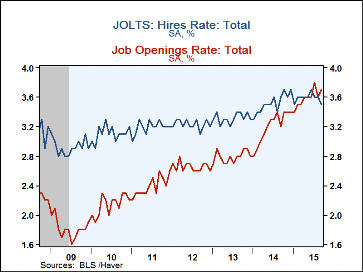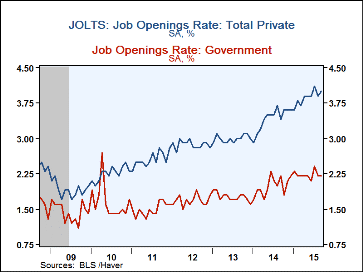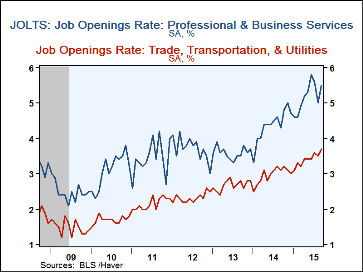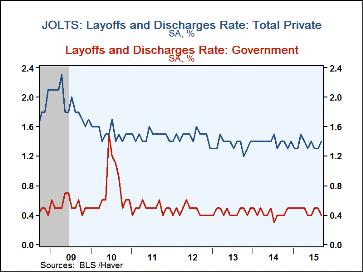 Global| Nov 12 2015
Global| Nov 12 2015U.S. JOLTS: Job Openings Rate Inches Higher but Hiring Dips
by:Tom Moeller
|in:Economy in Brief
Summary
The job openings rate rose to 3.7% during September from 3.6% during August. The latest figure compared to 3.2% one year earlier and remained near the highest level of the economic recovery. The private sector job openings rate of [...]
The job openings rate rose to 3.7% during September from 3.6% during August. The latest figure compared to 3.2% one year earlier and remained near the highest level of the economic recovery. The private sector job openings rate of 4.0% compared to 2.2% in the public sector. The job openings rate is the number of job openings on the last business day of the month as a percent of total employment plus job openings. Employers are having difficulty finding workers. The hires rate declined to 3.5%, its lowest level since January. The private sector rate of 3.9% compared to 1.5% in the public sector. The hires rate is the number of hires during the month divided by employment. The Bureau of Labor Statistics reports these figures in its Job Openings & Labor Turnover Survey (JOLTS).
The actual number of job openings rose 2.8% m/m to 5.526 million and was 18.1% higher versus last year. A 19.7% y/y rise in private sector openings was led by a 35.3% y/y gain in professional & business services. That was followed by 24.4% y/y increase in health care & social assistance job openings. Factory sector openings increased 9.6% y/y while leisure & hospitality openings improved 5.3% y/y. In the government sector, job openings increased 4.8% y/y.
The number of hires dipped 0.6% m/m to 5.049 million (-0.2% y/y). Private sector hiring eased 0.3% y/y reflecting an 8.3% y/y decline in professional & business services jobs and a 2.4% fall in health care & social assistance employment. Offsetting these declines was an 8.0% y/y gain in leisure & hospitality jobs and a 7.2% rise in construction hiring. The number of factory sector workers increased 1.4% y/y but government jobs dipped 0.3% y/y.
The total job separations rate remained steady m/m at 3.4% as separations were fairly stable y/y. Construction sector separations jumped 10.0% y/y and leisure & hospitality separations increased 8.6% y/y. Factory sector separations increased 5.7% y/y. and they rose 5.4% in retail trade. Health care separations rose 3.5% y/y but professional & business services separations fell 9.1% y/y. Separations include quits, layoffs, discharges, and other separations as well as retirements.
The layoff & discharge rate held steady at 1.2% m/m and y/y. The private sector rate of 1.4% compared to 0.4% in the public sector. Layoffs overall rose 2.2% y/y; 10.8% y/y in the public sector and 1.7% y/y amongst private sector firms.
The JOLTS survey dates to December 2000 and the figures are available in Haver's USECON database.
The U.S. Economic Outlook and Monetary Policy is the title of today's speech by N.Y. Fed President William C. Dudley and it can be found here.
| JOLTS (Job Openings & Labor Turnover Survey, SA) | Sep | Aug | Jul | Sep '14 | 2014 | 2013 | 2012 |
|---|---|---|---|---|---|---|---|
| Job Openings, Total | |||||||
| Rate (%) | 3.7 | 3.6 | 3.8 | 3.2 | 3.4 | 2.8 | 2.6 |
| Total (000s) | 5,526 | 5,377 | 5,668 | 18.1% | 22.6% | 9.3% | 3.2% |
| Hires, Total | |||||||
| Rate (%) | 3.5 | 3.6 | 3.6 | 3.6 | 42.2 | 39.8 | 38.8 |
| Total (000s) | 5,049 | 5,081 | 5,065 | -0.2% | 8.4% | 3.4% | 4.2% |
| Layoffs & Discharges, Total | |||||||
| Rate (%) | 1.2 | 1.2 | 1.2 | 1.2 | 14.5 | 14.6 | 15.5 |
| Total (000s) | 1,732 | 1,725 | 1,646 | 2.2% | 2.4% | -4.9% | 1.1% |
Tom Moeller
AuthorMore in Author Profile »Prior to joining Haver Analytics in 2000, Mr. Moeller worked as the Economist at Chancellor Capital Management from 1985 to 1999. There, he developed comprehensive economic forecasts and interpreted economic data for equity and fixed income portfolio managers. Also at Chancellor, Mr. Moeller worked as an equity analyst and was responsible for researching and rating companies in the economically sensitive automobile and housing industries for investment in Chancellor’s equity portfolio. Prior to joining Chancellor, Mr. Moeller was an Economist at Citibank from 1979 to 1984. He also analyzed pricing behavior in the metals industry for the Council on Wage and Price Stability in Washington, D.C. In 1999, Mr. Moeller received the award for most accurate forecast from the Forecasters' Club of New York. From 1990 to 1992 he was President of the New York Association for Business Economists. Mr. Moeller earned an M.B.A. in Finance from Fordham University, where he graduated in 1987. He holds a Bachelor of Arts in Economics from George Washington University.










